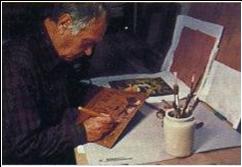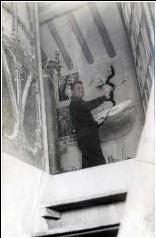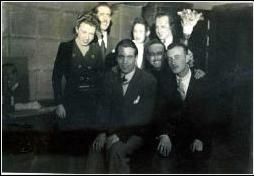
|
Circa 1935. Film poster painted in the Parra Co. studio. |
|
1941. In Alberto DuceLs studio in Zaragoza. From l. to r. and top to bottom: Pilar Aranda, Ildefonso Manuel Gil, Gloria (Mrs. Seral), Tomás Seral, Alberto Duce, Marcial Buj. (gChash) and Antonio Mingote. |
|
Circa 1947. Madrid. |
|
The beginnings. Zaragoza 1915. Lorenzo Alberto Duce Baquero is born in Zaragoza on August 10. From childhood he has the propensity towards drawing and painting. He develops his love towards nature and participates in outdoor activities organized by the hExploradores de Españah (Spanish Explorers) and at the same time he begins reading the classics. Towards 1929, he studies in the School of Commerce, he attends classes at the School of Arts and Trades and he begins to paint copies of paintings from the Zaragoza Museum of Fine Arts.
1930-1931. - He continues his studies in Commerce as an independent student and, at the same time, he works as a craftsman for the gRoldos Tyrolesesh, a publicity company. 1931-1933. - He shows us his first works in publicity and illustration and he frequents the "Goya Studio", a free style painting studio. He contributes ten works to the first public showing of this center (1933). Simultaneously, he broadens his training education studying French, English and German. In 1933 he travels throughout Germany and at this time he starts to work as a sketch artist in gIndustrias del Cartonajeh.
1934.-. He begins to illustrate covers, billboards and cinema backdrops for the Parra Company and he restarts his studies as an official student in the School of Commerce. He becomes a member of the Spanish University Federation, Students' Union, and Socialist Youths.
1936-1939.- At the start of the Spanish Civil War, quick intervention by the family saves him from the sentences that fall upon him for enrolling in the Legion. He makes posters and illustrates books, newspapers and magazines.
The decade of the forties: Zaragoza. Madrid. Paris. New York. 1940-1941. - He spends the summer of 1940 in Mallorca and, with the works that he paints there, he has his first individual exhibition in The Zaragoza Mercantile Center. Six months later he again exhibits in the Hall gLibrosh. He is asked to paint the mural for the no longer existing hotel complex gAmbos Mundos", in Zaragoza, for which he paints several murals. He is also interested in ceramics and ends up making a gView of Zaragozah and some friezes using this technique that he learns with Marceliano Soler Aliaga, a ceramist from Muel. Meanwhile, his drawings continue to illustrate the Zaragoza press. He begins his summer stays in the Spa of Panticosa (Huesca), for which he ends up painting a half-dozen works of great dimensions. He creates portraits for the spafs clientele and he visits the summits that surround the glacial ring upon which the spa is found. From these visits he takes notes of the landscapes which, on occasions, he puts on canvas.
1942-1946. - In 1942 he moves to Madrid where he is admitted as a student in Eduardo ChicharroLs studio. At the same time, he makes copies of works conserved in the gMuseo Del Pradoh, he attends drawing classes in the Circle of Fine Arts and he works intensely in his studio. He coincides with other painters such as Pedro Bueno, Pedro Mozos, Menchu Gal, Álvaro Delgado, Martínez Novillo, Agustín Redondela, Luís García Ochoa, Luís Castellanos, Irene Golberger and Rafael Zabaleta who also used to go to the gatherings at gLion d'Orh or to gCafe Gijónh. During the first half of the decade he continues to spend the summers in the Spa of Panticosa dedicating his time to painting. In 1943, he goes to Esparraguera (Barcelona) to paint the backdrop for the theatrical representation of gLa Pasión de Cristoh, of which only some sketches are preserved. He continues to maintain close contact with the artistic circles of Zaragoza, where he frequently returns and where he regularly exhibits. In the Halls of Aragonese Artists he obtains a Commendation, Painting Section, in the First (1943); Honorary Mention, Painting Section, in the Second (1944) and Medal of Honor, Painting Section, in the Fourth (1946). At the same time, he exhibits in Madrid, Valencia and Barcelona. Portraits, still life drawings and figure compositions are the genres which he most generates. The editorial Alejo Climent orders the edition of some monographs on the youth values of the Spanish artistic avant-guard and Duce selects Luís Castellanos, Cristino Mallo, and Rafael Zabaleta whose books are published between 1946 and 1947 in a Collection of Modern Art.
1947. - Alberto Duce's work consolidates and upon selection of two of his works to participate in the Exhibition of Contemporary Spanish Art in Argentina, he is recognized as a new value in the artistic panorama.
1948. - He obtains the III Medal, Painting Section, in the National Exhibition of Fine Arts, with gComposiciónh; he carries out an important exhibition in the Hall of Prints of Madridfs National Museum of Modern Art. He wins the Roma Prize; he gets a scholarship to the French Institute to study in Paris and the pension "Conde de Cartagena" from the Academy of Fine arts in Madrid, to go to study in New York.
1948-1949.- In Paris, he attends drawing and lithograph classes of La Grande Chaumière and of L'Ecole of Beaux Arts, at that time the interest in engraving becomes part of his artistic curriculum. He was fascinated with the cosmopolitan life of the great capital of the European culture; he visited its museums, exhibition halls and other artists' studios.
1949. - His gSanta Fazh obtains the Silver Medal, in the IV National Exhibition of Prints of the Passion which takes place in Madrid. At the end of the spring he returns to Madrid and, since there was time before filling the vacancy that he should occupy in Rome, he goes to New York, where he attends drawing classes at Art' Students League, he visits exhibitions, museums and he travels North stopping in Chicago. He sets up a studio on River Side Drive where he mainly paints portraits. He is impressed by the racial discrimination, the music, the style of American life, and by the economic level of the middle class so distant from that of the Spanish post war period. After some months in New York he decides to settle in Washington.
Washington 1950-1961. - He joins the staff of the Spanish Embassy as technical adviser in the Department of Culture, from there he tries to promote the Spanish contribution to the United States. He paints a mural in one of the domes of the Embassy building. During these years, he paints, above all, portraits, some of which he shows in New Mexico Art Alliance, Santa Fe (1950); in Arts Club, Washington (1951); The I.F.A. Galleries, Washington (1956), etc. He travels through several states admiring the generous beauty of the natural spaces, of those which he sometimes takes color notes, and he stays for some time in New Mexico where he carries out a series of religious sculptures and other popular themes, the "bultos." The news and the images of the North American troops in Korea (1950-1953) seen in the press, lead him to create drawings that express the anguish and neglect of the Korean population. He will later do the same with the Vietnam War.
Zaragoza-Madrid-Zaragoza 1962. - He returns to Spain during the first days of the year and after a short stay in Madrid, he settles in Zaragoza. He notices that during his absence new generations have transformed the concept of art in Spain, and he dedicates his time to drawing portraits.
1963-1964. – He returns to settle in Madrid and he again draws in the Circle of Fine Arts. He exhibits in Zaragoza and in Madrid. He participates in the National Exhibition of Fine Arts (1964) obtaining a Third Medal in the Drawing section.
1965. - He carries out his first pictorial essays with different mixed techniques; in the meantime, he continues painting preferably oil compositions. His interest grows in engraving in metal, a technique which he had begun to practice in the United States. He returns to Paris with a scholarship from the March Foundation to study engraving and stamping techniques in Haytterfs studio. One of his etchings obtains First Prize in the XVIII Christmas Art Exhibition "Galerías Preciadosh, in Madrid.
1966-1967.- He has fully incorporated a mixed technique in his easel compositions, in which he harmonizes his preference for drawing and pictorial matter in works in which the human figure is the main character, obtaining a very defined personal style. He participates in contests which provide him several awards: A prize in drawing, in the XVI Painting Hall of Africa and Prize Corporations (City council of Zaragoza) in the National Exhibition of Fine arts in which he takes gConciertoh, a canvas of mixed technique that represents several feminine figures, dressed with classic tunics, in front of the city of Toledo. In January 1967 he exhibits in Zaragoza in the Hall gCaja de Ahorros de la Immaculadah.
1968. - He carries out an important retrospective exhibition in the Hall of gDirección General de Bellas Artesh, Madrid. His participation in national competitions continues to award him prizes: Prize in Drawing, in the XVIII Painters of Africa Hall; Second Medal obtained in the XVII Engraving Hall (Homage to Goya), Second Prize in the XXI Exhibition of Christmas Art gGalerias Preciadosh and the prize "Julio Prieto Nespereira". In the XVIII Engraving Hall the command of etching and soft varnish, techniques mostly used by the artist, are recognized. The canvas gVíctimas Inocentesh, of almost a meter and a half by two meters, of mixed technique, outlines the horrors suffered by the Vietnamese population during the attack of the American troops, with which he obtained the Prize Corporations (Provincial Delegation of Badajoz) in the National Exhibition of Fine Arts.
1969-1970. - He takes engraving classes in the Circle of Fine Arts, where he sets up a stamping shop. 1970-1973. - He maintains an intense artistic activity in Madrid and in Zaragoza, where he gets many official and private assignments. He buys a farmhouse in a small town of the Catalan Priorate, where he will spend long periods of time in touch with nature, installing his engraving and stamping shop by the end of the decade. The friendly landscape of these lands, its soft hillsides covered with hazel trees, is reflected in his compositions. He carries out several exhibitions in various cities and gets First Prize, in Painting Section, in the XX Painting Hall of Africa (Madrid, 1970); Silver Palette, in First Biennial International Painting (Marbella, 1971); and First Medal, Painting Section, in XLIII Autumn Hall (Madrid, 1973).
1974. – The ten aquatint engravings with soft varnish that illustrate Safofs gPoemash (GISA Editions) are exhibited in Granada, Madrid and Zaragoza. It is a well cared for bibliophile edition whose theme is adapted to the characteristics of DuceLs work. He gets First Prize, in the VIII edition of painting "Circulo 2", of Madrid.
1975-1976. - He participates in "35 years of Aragonese painting in the Hall Libros" and exhibits in Pontevedra and Vigo.
1977. – He gets First Medal, Section Drawing, in XLV Hall Autumn, Madrid.
1978 - 1980.- He is commissioned several drawings by the minister of Defense, Rodríguez Sahagún, which include several portraits of the King, the Prince of Asturias, of the Government's President Adolfo Suárez, of the Vice-president Mellado Gutiérrez and other political leaders of the extinct UCD political party. 1980-1982. - He exhibits in Zaragoza, Madrid and Tarragona and he prepares the illustrations for gSoledad Ih by Góngora as commissioned by the editor Casariego, from Madrid. 1983. – The thirteen illustrations of gSoledad Ih are published in the collection gArt and Bibliophileh; the plates had been etched with aquatint and dry tip touches. Another edition for book lovers. He again returns to Zaragoza, dividing his life and work between this city and the studio shop installed in the Catalan farmhouse.
1984-1987.- He exhibits in Zaragoza, Huesca, Tarragona, Burgos, Madrid, etc. He gets first prize in the National Competition of Posters gInternational Year of Peace", Spanish Committee of United Cities (1986).
1988.- Among other exhibitions that he carries out, the one about his drawings, engravings and paintings stands out, which takes place in the hall of Palacio de Sástago, of the Provincial Delegation of Zaragoza. For "Círculo de Arte", he creates eight canvases that illustrate a new edition of SafoLs gPoemash.
1989-1995. - Retired from the circles of Madrid, he continues working as much in Zaragoza as in the Catalan farmhouse. He exhibits in Madrid, Zaragoza and Huesca. He receives the Prize Penagos, Drawing Section (1991).
1996-1997. – Always interested in the works of Velázquez, Vermeer, Rembrandt and Goya, main painters that shaped his gimaginary museumh he feels the recreational necessity to reinterpret them appealing to the geometrization of the figures and the flat inks. He retakes airbrushing and stenciling, and he again uses the techniques with which he began in his youth in a d'après series on the works of the painters mentioned above. 1998. - He transfers to Zaragoza the stamping and engraving shop and continues being devoted to engraving and painting with juvenile intensity.
2002. – During the summer, a retrospective exhibition takes place in the Museum Camón Aznar, in Zaragoza, organized by Ibercaja. The painter attends this exposition already suffering from poor health. He is named gAcadémico de Honor de la Real de Nobles y Bellas Artes de San Luís de Zaragozah. 2003. - He dies in Zaragoza on August 28th. |




|
1962. Plaza del Pilar, Zaragoza. |
|
July 1973. From l. to r. Gregorio Prieto, Alberto Duce and José Gerardo Manrique de Lara. Santander. |
|
1987. Vasarely Foundation, Aix-en-Provence. |
|
12-21-1956. Catalog and newspaper clipping on the inauguration of the exhibition gYoung Women of the Embassiesh, Washington. |

|
1961. LothianLs studio, U.S.A. |





|
1943. In front of the sketch for gLa calle de las amargurash, a backdrop for the performance of La Pasión, Esparraguera (Barcelona). |

|
Álvaro Delgado |
|
Pancho Cossío |
|
Milicua |
|
Sra.de A.Delgado |
|
A. Duce |



|
Circa 1992. In front of self portrait from 1944. |
|
1975. In his workshop. |